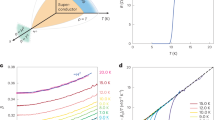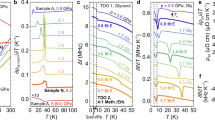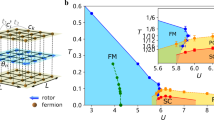Abstract
A fundamental question for high-temperature superconductors is the nature of the pseudogap phase, which lies between the Mott insulator at zero doping and the Fermi liquid at high doping p (refs 1, 2). Here we report on the behaviour of charge carriers near the zero-temperature onset of this phase, namely at the critical doping p*, where the pseudogap temperature T* goes to zero, accessed by investigating a material in which superconductivity can be fully suppressed by a steady magnetic field. Just below p*, the normal-state resistivity and Hall coefficient of La1.6−xNd0.4SrxCuO4 are found to rise simultaneously as the temperature drops below T*, suggesting a change in the Fermi surface with a large associated drop in conductivity. At p*, the resistivity shows a linear temperature dependence as the temperature approaches zero, a typical signature of a quantum critical point3. These findings impose new constraints on the mechanisms responsible for inelastic scattering and Fermi-surface transformation in theories of the pseudogap phase1,4,5,6,7,8.
This is a preview of subscription content, access via your institution
Access options
Subscribe to this journal
Receive 12 print issues and online access
$259.00 per year
only $21.58 per issue
Buy this article
- Purchase on SpringerLink
- Instant access to full article PDF
Prices may be subject to local taxes which are calculated during checkout




Similar content being viewed by others
References
Lee, P. A., Nagaosa, N. & Wen, X.-G. Doping a Mott insulator: Physics of high-temperature superconductivity. Rev. Mod. Phys. 78, 17–85 (2006).
Timusk, T. & Statt, B. The pseudogap in high-temperature superconductors: An experimental survey. Rep. Prog. Phys. 62, 61–122 (1999).
v Löhneysen, H., Rosch, A., Vojta, M. & Wölfle, P. Fermi-liquid instabilities at magnetic quantum phase transitions. Rev. Mod. Phys. 79, 1015–1075 (2007).
Yang, K.-Y., Rice, T. M. & Zhang, F.-C. Phenomenological theory of the pseudogap state. Phys. Rev. B 73, 174501 (2006).
Haule, K. & Kotliar, G. Avoided criticality in near-optimally doped high-temperature superconductors. Phys. Rev. B 76, 192503 (2007).
Kivelson, S. A. et al. How to detect fluctuating stripes in the high-temperature superconductors. Rev. Mod. Phys. 75, 1201–1241 (2003).
Chakravarty, S., Laughlin, R. B., Morr, D. K. & Nayak, C. Hidden order in the cuprates. Phys. Rev. B 63, 094503 (2001).
Varma, C. Non-Fermi-liquid states and pairing instability of a general model of copper oxide metals. Phys. Rev. B 55, 14554–14580 (1997).
Ando, Y. et al. Evolution of the Hall coefficient and the peculiar electronic structure of the cuprate superconductors. Phys. Rev. Lett. 92, 197001 (2004).
Hussey, N. E. et al. Observation of a coherent three-dimensional Fermi surface in a high-transition temperature superconductor. Nature 425, 814–817 (2003).
Nakamae, S. et al. Electronic ground state of heavily-overdoped non-superconducting La2−xSrxCuO4 . Phys. Rev. B 68, 100502 (2003).
Mackenzie, A. P. et al. Normal-state magnetotransport in superconducting Tl2Ba2CuO6+y to millikelvin temperatures. Phys. Rev. B 53, 5848–5855 (1996).
Nakamura, Y. & Uchida, S. Anisotropic transport properties of single-crystal La2−y−xNdySrxCuO4: Effect of the structural phase transition. Phys. Rev. B 46, 5841–5844 (1992).
Ando, Y. et al. Electronic phase diagram of high-Tc cuprate superconductors from a mapping of the in-plane resistivity curvature. Phys. Rev. Lett. 93, 267001 (2004).
Varma, C. M. et al. Phenomenology of the normal state of Cu–O high-temperature superconductors. Phys. Rev. Lett. 63, 1996–1999 (1989).
Tallon, J. L. & Loram, J. W. The doping dependence of T*—what is the real high-Tc phase diagram? Physica C 349, 53–68 (2001).
Motoyama, E. M. et al. Spin correlations in the electron-doped high-transition-temperature superconductor Nd2−xCexCuO4±δ . Nature 445, 186–189 (2007).
Fournier, P. et al. Insulator–metal crossover near optimal doping in Pr2−xCexCuO4: anomalous normal-state low-temperature resistivity. Phys. Rev. Lett. 81, 4720–4723 (1998).
Dagan, Y. et al. Evidence for a quantum phase transition in Pr2−xCexCuO4−δ from transport measurements. Phys. Rev. Lett. 92, 167001 (2004).
Ichikawa, N. et al. Local magnetic order vs superconductivity in a layered cuprate. Phys. Rev. Lett. 85, 1738–1741 (2000).
Hunt, A. W. et al. Glassy slowing of stripe modulation in (La,Eu,Nd)2−x(Sr,Ba)xCuO4: A 63Cu and 139La NQR study down to 350 mK. Phys. Rev. B 64, 134525 (2001).
Niemöller, T. et al. Charge stripes seen with X-rays in La1.45Nd0.4Sr0.15CuO4 . Eur. Phys. J. B 12, 509–513 (1999).
Fink, J. et al. Charge order in La1.8−xEu0.2SrxCuO4 studied by resonant soft X-ray diffraction. Preprint at <http://arxiv.org/abs/0805.4352> (2008).
Adachi, T., Noji, T. & Koike, Y. Crystal growth, transport properties, and crystal structure of the single-crystal La2−xBaxCuO4 (x=0.11). Phys. Rev. B 64, 144524 (2001).
Takeshita, N et al. Giant anisotropic pressure effect on superconductivity within the CuO2 plane of La1.64Eu0.2Sr0.16CuO4: Strain control of stripe criticality. J. Phys. Soc. Jpn. 73, 1123–1126 (2004).
LeBoeuf, D. et al. Electron pockets in the Fermi surface of hole-doped high-Tc superconductors. Nature 450, 533–536 (2007).
Millis, A. J. & Norman, M. R. Antiphase stripe order as the origin of electron pockets observed in 1/8-hole-doped cuprates. Phys. Rev. B 76, 220503 (2007).
Ossadnik, M., Honerkamp, C., Rice, T. M. & Sigrist, M. Breakdown of Landau theory in overdoped cuprates near the onset of superconductivity. Preprint at <http://arxiv.org/abs/0805.3489> (2008).
Boebinger, G. S. et al. Insulator-to-metal crossover in the normal state of La2−xSrxCuO4 near optimum doping. Phys. Rev. Lett. 77, 5417–5420 (1996).
Balakirev, F. F. et al. Fermi surface reconstruction at optimum doping in high-Tc superconductors. Preprint at <http://arxiv.org/abs/0710.4612> (2007).
Nachumi, B. et al. Muon spin relaxation study of the stripe phase order in La1.6−xNd0.4SrxCuO4 and related 214 cuprates. Phys. Rev. B 58, 8760-8772 (1998).
Acknowledgements
We thank K. Behnia, A. Chubukov, P. Coleman, Y.B. Kim, S.A. Kivelson, G. Kotliar, K. Haule, G.G. Lonzarich, A.J. Millis, M.R. Norman, C. Proust, T.M. Rice, S. Sachdev, T. Senthil, H. Takagi and A.-M.S. Tremblay for discussions, and J. Corbin for his assistance with the experiments. L.T. acknowledges support from the Canadian Institute for Advanced Research and funding from NSERC, FQRNT, and a Canada Research Chair. L.B. was supported by NHMFL-UCGP and Y.J.J. by the NHMFL-Schuller fellow program. J.S.Z. and J.B.G. were supported by an NSF grant. The NHMFL is supported by an NSF grant and the State of Florida.
Author information
Authors and Affiliations
Corresponding author
Supplementary information
Supplementary Information
Supplementary Informations (PDF 249 kb)
Rights and permissions
About this article
Cite this article
Daou, R., Doiron-Leyraud, N., LeBoeuf, D. et al. Linear temperature dependence of resistivity and change in the Fermi surface at the pseudogap critical point of a high-Tc superconductor. Nature Phys 5, 31–34 (2009). https://doi.org/10.1038/nphys1109
Received:
Accepted:
Published:
Issue date:
DOI: https://doi.org/10.1038/nphys1109
This article is cited by
-
Hopping frustration-induced flat band and strange metallicity in a kagome metal
Nature Physics (2024)
-
Absence of a BCS-BEC crossover in the cuprate superconductors
npj Quantum Materials (2023)
-
Reconciling scaling of the optical conductivity of cuprate superconductors with Planckian resistivity and specific heat
Nature Communications (2023)
-
Interplay between superconductivity and the strange-metal state in FeSe
Nature Physics (2023)
-
Nd:YAG infrared laser as a viable alternative to excimer laser: YBCO case study
Scientific Reports (2023)



